

Agricultural biotech.
Other pieces. Enhancement. Genetic Enhancement - definition. Genetic Enhancement In general, genetic enhancement refers to the transfer of genetic material intended to modify nonpathological human traits.
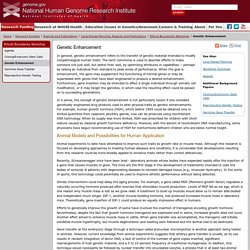
The term commonly is used to describe efforts to make someone not just well, but better than well, by optimizing attributes or capabilities -- perhaps by raising an individual from standard to peak levels of performance. When the goal is enhancement, the gene may supplement the functioning of normal genes or may be superseded with genes that have been engineered to produce a desired enhancement.
Furthermore, gene insertion may be intended to affect a single individual through somatic cell modification, or it may target the gametes, in which case the resulting effect could be passed on to succeeding generations. In a sense, the concept of genetic enhancement is not particularly recent if one considers genetically engineered drug products used to alter physical traits as genetic enhancements. Animal Models and Possibilities for Human Application.
Things we can grow. Growing cells. Building breast tissue. Karen Burg wants to heal the minds and bodies of women who survive breast cancer.
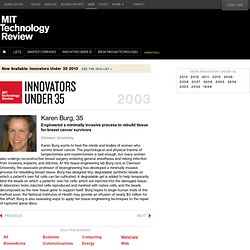
The psychological and physical trauma of lumpectomies and mastectomies is bad enough, but many women also undergo reconstructive breast surgery, enduring general anesthesia and risking infection from incisions, implants, and stitches. At the tissue-engineering lab Burg runs at Clemson University, the associate professor of bioengineering has developed a minimally invasive process for rebuilding breast tissue. Burg has designed tiny, degradable synthetic beads on which a patient’s own fat cells can be cultivated. A degradable gel is added to help temporarily bind the beads on which a patients’ own fat cells, which are injected into the damaged tissue.
Engineering News at NC State. November 15, 2004 You can hear the excitement in Dr.
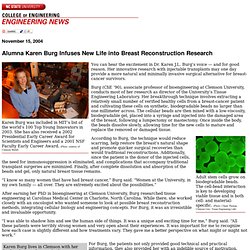
Karen J.L. Burg’s voice — and for good reason. Her innovative research with injectable transplants may one day provide a more natural and minimally invasive surgical alternative for breast-cancer survivors. Burg (ChE ’90), associate professor of bioengineering at Clemson University, conducts most of her research as director of the University’s Tissue Engineering Laboratory. According to Burg, the technique would reduce scarring, help restore the breast’s natural shape and promote quicker surgical recoveries than would traditional reconstructions.
“I know so many women that have had breast cancer,” Burg said. ReCell Kit Grows Spray On Skin At Your Bedside In Just Half an Hour. List of current items. Organovo. Anthony Atala: Growing new organs. Bioteeth. New research may result in bio-engineered replacement teeth which are generated from a person’s own gum cells (Photo: Shutterstock) New research funded by the National Institute for Health Research (NIHR) Biomedical Research Centre and King's College London, UK, may result in bio-engineered replacement teeth which are generated from a person’s own gum cells.
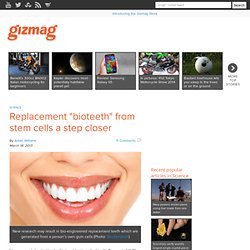
Though artificial whole-tooth implants are currently available to people who are missing a tooth, such implants are unable to fully reproduce the natural root structure of a tooth. This means that in time, friction caused by eating and other movement of the jaw can result in a loss of jaw bone. Previous research toward producing bio-engineered teeth (or “bioteeth”) has focused on the growing of new teeth by using embryonic cells inserted into an adult jaw as “pellets.” Despite the marked difference in environment, such immature teeth (teeth primordia) can develop into normal adult teeth given the right conditions. About the Author. Dental hard tissue -2006. Printing body parts: Making a bit of me. Lab-Grown Lungs - The 50 Best Inventions of 2010. Growing new body parts has always been more science fiction than science reality, but that balance may quickly be shifting, at least in the lab.
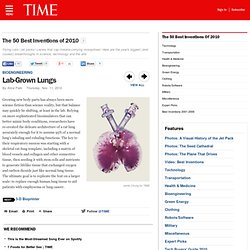
Relying on more sophisticated biosimulators that can better mimic body conditions, researchers have re-created the delicate architecture of a rat lung accurately enough for it to assume 95% of a normal lung's inhaling and exhaling functions. The key to their respiratory success was starting with a skeletal rat-lung template, including a matrix of blood vessels and collagen and other connective tissue, then seeding it with stem cells and nutrients to generate lifelike tissue that exchanged oxygen and carbon dioxide just like normal lung tissue.
The ultimate goal is to replicate the feat on a larger scale: to replace enough human lung tissue to aid patients with emphysema or lung cancer. Next 3-D Bioprinter. Scientists use magnetic levitation to make in vitro lung tissue more realistic. In a development that could lead to faster and more effective toxicity tests for airborne chemicals, scientists from Rice University and the Rice spinoff company Nano3D Biosciences have used magnetic levitation to grow some of the most realistic lung tissue ever produced in a laboratory.
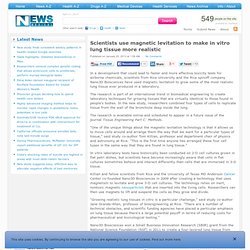
The research is part of an international trend in biomedical engineering to create laboratory techniques for growing tissues that are virtually identical to those found in people's bodies. In the new study, researchers combined four types of cells to replicate tissue from the wall of the bronchiole deep inside the lung. The research is available online and scheduled to appear in a future issue of the journal Tissue Engineering Part C: Methods. Killian and fellow scientists from Rice and the University of Texas MD Anderson Cancer Center co-founded Nano3D Biosciences in 2009 after creating a technology that uses magnetism to levitate and grow 3-D cell cultures. Roadblocks to use of tissue engineering. Nina Tandon: Could tissue engineering mean personalized medicine? Drug screening. New pluripotent cell. The top middle panel shows endogenous pluripotent somatic (ePS) cells, which can give rise to many tissue derivatives, including pancreas, bone, intestine, breast and cartilage cells.

Scientists at UC San Francisco discovered that rare somatic cells extracted from human breast tissue are pluripotent cells that could play an important role in regenerative medicine. As with human embryonic stem cells, the newly found cells are pluripotent, or capable of turning into most cell types, the authors said.
The scientists discovered that when the cells were put either in mice, or in cell culture, the cells could differentiate to produce multiple cell types, including those that proceed to make heart, intestine, brain, pancreas and even cartilage. The finding is significant, the authors said, because scientists previously believed that pluripotent cells did not exist in the body after the embryonic stage of human development. Unique Characteristics of Newly Discovered Cells Image: UC San Francisco. Kevin Stone: The bio-future of joint replacement.
Animal implants for people in tissues and ligaments. Types of tissue engineering. Tissue engineering. IUPAC definition Use of a combination of cells, engineering and materials methods, and suitable biochemical and physico-chemical factors to improve or replace biological functions.[1] Note: While most definitions of tissue engineering cover a broad range of applications, in practice the term is closely associated with applications that repair or replace portions of or whole tissues (i.e., bone, cartilage, blood vessels, bladder, skin, etc.).[2] Overview[edit]
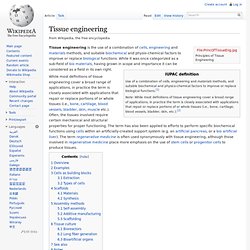
Materials Today - Fibrous proteins and tissue engineering. Fibrous proteins are finding broad impact in biomaterial systems for a range of cell and tissue studies.

This impact derives from an improved insight into fundamental structure-function relationships, as well as the unique material properties attained with these protein polymers. Recent advances in the use of these protein systems in a variety of biomaterial and tissue engineering applications are reviewed, with a focus on approaches to control the structure, chemistry, and morphology of the biomaterials formed and enable cell and tissue outcomes to be directed in vitro and in vivo. Fibrous proteins such as collagens, elastins, and silks are characterized by highly repetitive amino acid sequences that primarily provide mechanical and architectural functions in nature. The repetitive primary sequences result in the formation of relatively homogeneous secondary structures via self-assembly, leading to the formation of fibrous structural materials. Fibrous protein chimeras Fig. 1. Fig. 2. Biomaterials - Autologous extracellular matrix scaffolds for tissue engineering.
Abstract Development of autologous scaffolds has been highly desired for implantation without eliciting adverse inflammatory and immune responses.

However, it has been difficult to obtain autologous scaffolds by tissue decellularization because of the restricted availability of autologous donor tissues from a patient. Here we report a method to prepare autologous extracellular matrix (aECM) scaffolds by combining culture of autologous cells in a three-dimensional template, decellularization, and template removal. The aECM scaffolds showed excellent biocompatibility when implanted. We anticipate that “Full Autologous Tissue Engineering” can be realized to minimize undesirable host tissue responses by culturing the patient’s own cells in an aECM scaffold. Keywords. Genetic engineering. Genetic engineering, also called genetic modification, is the direct manipulation of an organism's genome using biotechnology. New DNA may be inserted in the host genome by first isolating and copying the genetic material of interest using molecular cloning methods to generate a DNA sequence, or by synthesizing the DNA, and then inserting this construct into the host organism.
Genes may be removed, or "knocked out", using a nuclease.